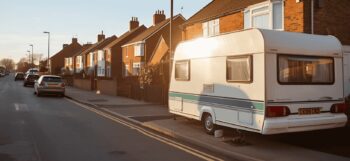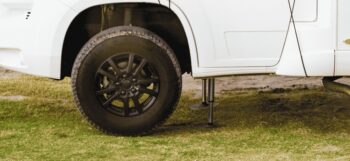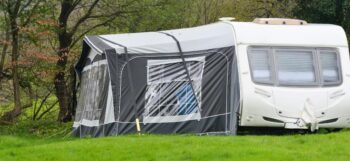Just like your car, motorhomes need regular maintenance for them to stay in tip-top condition. Everything from your tyres and engine to your internal lights and water tanks need checking from time to time.
Neglecting basic motorhome maintenance can lead to unnecessary risks, especially when it comes to your safety. To help you stay prepared, we've put together a comprehensive motorhome maintenance checklist, covering everything you need to keep your motorhome safe and running smoothly.
Exterior motorhome maintenance checks
Exterior checks make sure your motorhome is roadworthy and help you stay compliant with your legal obligations on the road. Here are some key maintenance checks to carry out on your motorhome.
Clear the roof
The roof of your motorhome is often overlooked, but it’s crucial for your motorhome to run safely. A clear roof prevents potential road hazards and also helps maintain fuel efficiency by reducing unnecessary drag. Before any journey, inspect the roof for debris such as leaves, branches, or dirt, which can damage the surface or block vents.
Make sure you pay close attention to seams and seals too. These areas are prone to wear and can develop leaks over time. Check around any installed air conditioning units or vents to see if they’re secure and free from cracks that might let water through.
If your motorhome has a rubber roof, consider applying an annual treatment to protect it from UV damage and weathering. Doing so can extend the lifespan of the roof and help you avoid costly repairs caused by cracking or degradation.

Examine tyre pressure and health
Regularly checking tyre condition, pressure, and age should be a key part of your motorhome maintenance checklist.
Start by inspecting your tyres for visible damage such as cracks, bulges, or uneven wear. Pay close attention to their age as well—even if they appear in good condition, tyres over six years old may need replacing. Tyres degrade naturally over time, so remember to check for signs of wear regularly.
Maintaining the correct tyre pressure is equally important. Failing to inflate your tyres properly doesn’t just have an impact on your motorhome performance—it can also put your safety at risk. Generally, you should check tyre pressure at least once a month and always before a long journey.
For added convenience, consider buying a tyre pressure monitoring system (TPMS). These provide instant updates on tyre pressure and temperature, alerting you if anything seems unusual.
Check exterior lights
Aside from providing road visibility, working exterior lights are also a legal requirement and essential for your safety. Failing to keep your exterior lights working can result in fines or other penalties, so be sure to check bulbs frequently.
Here are the exterior lights you should test:
- Headlights: Ensure both high and low beams work.
- Indicators: Test all turn signals to make sure they flash correctly.
- Brake Lights: Make sure they illuminate when you press the brake pedal.
- Rear Lights: Check the rear lights to confirm they work during low-light conditions.
- Fog lights: These should be working correctly so that you can see in poor visibility.
- Number plate lights: These must be working for legal requirements, especially when driving at night.
Inspect the windscreen
As part of your motorhome maintenance checklist, carefully inspect it for chips, cracks, or scratches that could impede your vision or worsen over time. Even minor damage can expand, particularly with changes in temperature.
Don’t overlook the interior of the windscreen either. This can often gather dirt, dust, or condensation that can block your visibility, so clean it regularly with glass cleaner.
You should also inspect the condition of your wiper blades. Worn or damaged blades can leave streaks, reduce visibility in rain, and even scratch the windscreen. Replace them if they show signs of wear and ensure the washer fluid is full.
Check the engine
The engine keeps your motorhome running, so you’ll need regular servicing to ensure it’s in good working order. Scheduled engine maintenance makes sure critical components like the timing belt and spark plugs are inspected and replaced as needed. In turn, this can prevent breakdowns and extend the lifespan of your motorhome.
Although you’ll need professional engine inspections, you can also carry out basic checks yourself. Here are some inspections you can do:
- Oil levels: Check the oil level using the dipstick and top up if needed. Fresh, clean oil is crucial for keeping the engine lubricated and running smoothly.
- Air and fuel filters: Inspect filters for dirt and debris. Clean or replace them as recommended in your motorhome’s manual to maintain fuel efficiency and engine performance.
- Coolant: Ensure the coolant level is sufficient and the fluid is clean. Coolant prevents the engine from overheating, which is particularly important on long journeys.
- Brake fluid: Check the brake fluid level is within the recommended range, as low levels can impact braking performance.
Assess the brakes
Regular brake inspections and maintenance by a certified mechanic are essential. Mechanics make sure your brakes are in optimal condition and can respond effectively in all situations. Otherwise, you could risk your safety and that of your passengers.
Typically, brakes should be professionally inspected at least once a year. You might need more frequent checks if you regularly drive long distances or through tough conditions like snow or on harsh surfaces.
Pay attention to signs of potential brake issues. These might include:
- Sticking or grinding: If the brakes feel sticky or you hear grinding noises, this could indicate worn brake pads or issues with the brake mechanism.
- Reduced responsiveness: If you notice decreased braking efficiency or a spongy feel in the brake pedal, it’s time to have them inspected.
- Handbrake issues: Ensure the handbrake engages and releases smoothly without excessive resistance.
Take care of your starter and leisure batteries
Starter batteries are one of the most common causes of motorhome breakdowns, so they need to be in good condition to keep you on the move. Before any trip, check your starter battery to ensure it is functioning properly.
When winterising your motorhome, make sure to disconnect the starter battery correctly to prevent damage from cold temperatures or infrequent use. For detailed guidance on other checks to prepare your motorhome for winter, read our article on winterising your motorhome.
If your motorhome uses a leisure battery, proper maintenance is also key. After all, this battery is essential for operating lighting, heating, and appliances, which contribute to your comfort and safety in your motorhome.
To learn more about leisure battery care, including tips on charging and prolonging its lifespan, read our article on motorhome leisure batteries.
Maintain the tanks
Proper maintenance of your motorhome’s tanks is crucial for hygiene, functionality, and comfort while travelling. Most motorhomes feature three main types of tanks:
- Freshwater tanks: Store clean water for drinking, cooking, and washing.
- Grey waste tanks: Collect wastewater from sinks and showers.
- Black tanks: Hold waste from the toilet.
Each tank type requires regular care to prevent issues like unpleasant odours, contamination, or blockages.
Freshwater tanks
Freshwater tanks must be cleaned and sanitised regularly to maintain water quality. Replace filters annually to prevent the build-up of bacteria or sediment so that your water stays safe for consumption. For more detailed steps on tank cleaning, see our guide on motorhome water tank maintenance.
Grey waste tanks
Grey tanks need periodic flushing to prevent build-ups of grease or soap residue, which can cause blockages. Use grey tank cleaning solutions as needed and always drain the tank at designated waste points to maintain hygiene.
Black tanks
Black tanks require careful management to prevent odours and blockages. Use appropriate chemicals to break down waste and regularly flush the tank after emptying it. Inspect seals and fittings around the tank for leaks or damage.

Check the awnings
Awnings are prone to mould, mildew, and dirt build-up, which can cause damage. This can reduce their lifespan if not properly maintained. To prevent issues, follow these key steps:
- Dry before storage: Storing a wet awning can encourage the growth of mould and mildew, leading to unpleasant odours and potential fabric damage. Always allow your awning to dry completely before retracting it.
- Carry out annual cleaning: Before storing your motorhome for winter, clean the awning with a mild detergent and water. This removes dirt and debris that could damage the material during storage.
- Inspect seals: Check the seals and mounting points for any signs of wear or damage. Make sure all moving parts operate smoothly and are free from rust or corrosion—including hinges and arms.
Interior motorhome maintenance checks
The inside of your motorhome is just as important as the outside, especially for comfort, safety, and functionality. Here are the key checks to include in your motorhome maintenance checklist.
Test internal appliances
Faulty or malfunctioning equipment can disrupt your plans, so make sure everything is in working order before you set off. During your inspection, look for signs of wear, unusual noises, or poor performance.
Key appliances to check include:
- Ovens and stoves: Ensure they ignite properly and heat correctly.
- Fridges and freezers: Make sure they’re set to the right temperature and switch between power sources if applicable (e.g., gas and electric).
- Heating and air conditioning systems: Confirm they operate effectively for temperature control.
- Water pumps and showers: Check for proper flow and leaks.
Test water heater and hot water tanks
To avoid any surprises on the road, test your water heater and hot water tanks before you set off. Here are some key factors to look for:
- Proper functioning: Test the water heater to ensure it warms up efficiently.
- Leaks: Check for any signs of leaks around the tank or fittings.
- Sediment accumulation: If your motorhome has been stored outdoors, sediment or mineral build-up can occur, reducing the efficiency of the heater and tank. Flush the system periodically to remove debris and maintain performance.
Check for damp and moisture
Damp and moisture can cause significant damage to your motorhome if left unchecked, which can create structural issues and unfavourable living conditions.
It’s particularly important to monitor for damp during the winter months and after winter storage, as colder, wetter conditions increase the likelihood of moisture buildup. You can help prevent dampness by maintaining good ventilation and using dehumidifiers to trap moisture if needed.
To check for damp, look out for the following signs:
- Musty smells: A damp or stale odour often indicates moisture trapped inside.
- Black spots or mould: Inspect walls, ceilings, and corners for signs of mould growth.
- Soft or warped surfaces: Check for areas that feel soft to touch, which could indicate water damage.
Check internal lights
Proper lighting helps you move around safely, especially at night, and enhances the overall usability of your living space. Check that all bulbs are working and inspect fixtures for any loose wiring or damage.
Key internal lights to check include:
- Ceiling lights: Make sure they illuminate properly and replace bulbs if needed.
- Reading lights: Test lights in sleeping or seating areas for functionality.
- Bathroom lights: Be sure they’re bright and provide enough visibility.
- Step and floor-level lights: These are crucial for preventing trips and falls, particularly in low-light conditions.
Carry out cleaning and general maintenance
Regular cleaning and general upkeep can make a big difference to your motorhome’s condition. A clean and well-maintained interior and exterior can prevent issues that may affect water systems, appliances, and even the structure of the vehicle.
Keep your motorhome protected with insurance from Lifesure
Maintaining your motorhome is key for safe, comfortable, and enjoyable travels. But no matter how well-prepared you are, unexpected events can happen. That’s why having insurance in place is a good idea to help offer additional peace of mind on the road.
At Lifesure, we offer specialised motorhome insurance to help protect your motorhome, your belongings, and the passengers you take on your travels. Our insurance can include cover for window damage, camping equipment, lost keys, and more.
To request a quote, give us a call on 01480 402 460 or get in touch via our website.
Disclaimer: The sole purpose of this article is to provide guidance on the issues covered. This article is not intended to give legal advice, and, accordingly, it should not be relied upon. It should not be regarded as a comprehensive statement of the law and/or market practice in this area. We make no claims as to the completeness or accuracy of the information contained herein or in the links which were live at the date of publication. You should not act upon (or should refrain from acting upon) information in this publication without first seeking specific legal and/or specialist advice. Arthur J. Gallagher Insurance Brokers Limited trading as Lifesure accepts no liability for any inaccuracy, omission or mistake in this publication, nor will we be responsible for any loss which may be suffered as a result of any person relying on the information contained herein.











